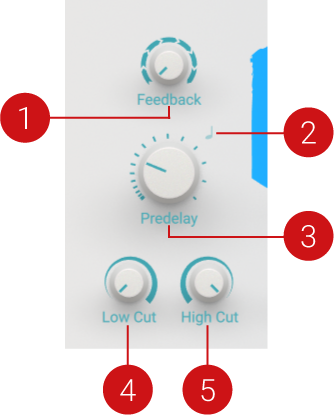Predelay and Filters
RAUM's Predelay section defines the timing of the reverb's onset and adds feedback, which you can use to create echo effects.
Predelay defines the timing of the reverb's onset by adding an initial delay to the reverb signal. RAUM's Predelay section sets itself apart from common reverb effects by adding feedback, which you can use to create echo effects. Additionally, Predelay can not only be set in milliseconds, but also in musical intervals synced to the host tempo. Therefore, you can use the predelay for rhythmic effects or to create synchronized echoes.
The feedback is optimized for a clean sound. Therefore it produces delay repetitions without any signal degradation. Additionally, a built-in limiter prevents excessive signal levels when an input signal is added to the delay repetitions. In this case, the input signal effectively ducks the delay sound.
Tip
By setting Feedback to 100%, you can use the predelay as a basic looper. The length of the loop is set using the Predelay control. When activating the Predelay Sync function, you can set the loop length in musical intervals up to four bars (64|4).
Combined with the reverb algorithms, it is possible to achieve unique spatial effects beyond classic echo and reverb. Since Predelay can be set in a wide range from below 1 ms to 2 seconds, you can fine-tune the reverb's onset as well as use the predelay for stretched-out repeater effects.
Tip
Comb filter sounds: By combining low Predelay with high Feedback values, you can use the predelay as a comb filter that adds a distinct tonal quality to the sound. The comb filtering effects are most obvious with sustained input signals. Percussive input signals can be used for resonator sounds similar to physical modelling. Adjust Predelay in fine increments to change the pitch of the tone. Automating Predelay produces flanging effects. You can use the Airy algorithm to add depth and texture to the sound. Cosmic allows for more extreme effects as it directly interacts with the predelay's feedback.
The Low Cut and High Cut filters allow you to adjust the overall tone of the effect by not only shaping the frequency contents of the reverb effect, but also the predelay's feedback signal. Therefore, delay repetitions are affected progressively. You can use this to create analog-style echo effects.
The Predelay section contains the following parameters:

Feedback: Adjusts the level of the feedback signal from the output of the predelay to its input, effectively increasing the number of delay repetitions. Turning Feedback to the right creates echo effects that can be further processed using the selected reverb algorithm. When Feedback is set to 100%, you can achieve infinite delay repeats and therefore use the predelay as a looper. A built-in limiter controls the level when high feedback settings are used with loud input signals.
Predelay Sync: Synchronizes the predelay to the host tempo and replaces the Predelay control with the Predelay Sync controls.
Predelay: Adjusts the duration of the predelay, which is the time it takes for the reverb effect to set in. By increasing the predelay, you can add separation between the input signal and the reverb signal. When Predelay Sync is activated, the predelay is synchronized to the host and the Predelay control is replaced by the Predelay Sync controls:

The Numerator (a) and Denominator (b) set the speed of modulation in musical notes relative to the host tempo. The Numerator sets the number of notes, while the Denominator sets the note value. The Sync Mode (c) sets the time value, or subdivision, for the chosen note value. For example, 1|4 in Sync Mode Straight means that the modulation repeats its cycle after one quarter note, and 3|2 in Sync Mode Triplet means that the modulation repeats its cycle after three half note triplets.
Low Cut: Attenuates low-frequency content of the reverb effect and the predelay's feedback signal by applying a low-shelf filter in the range of 0 dB to -24 dB. Turning the control to the left decreases the attenuation. Turning the control to the right increases the attenuation. Turning the control fully to the left switches the filter off.
High Cut: Attenuates high-frequency content of the reverb effect and the predelay's feedback signal by applying a high-cut filter in the range of 90 kHz to 1 kHz. Turning the control to the left increases the attenuation. Turning the control to the right decreases the attenuation. Turning the control fully to the right switches the filter off.
Note
When Predelay is set to 0 ms, Feedback does not have an effect on the sound. To indicate this, the control is greyed out. It is still possible to make adjustments, however they will only take effect once Predelay is set to a value other than 0 ms.